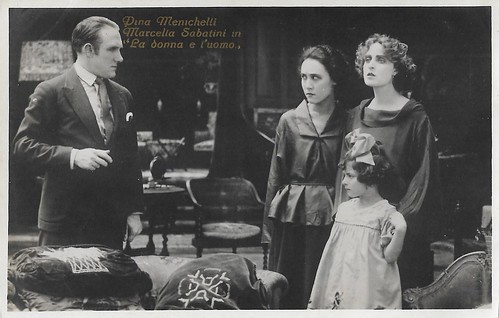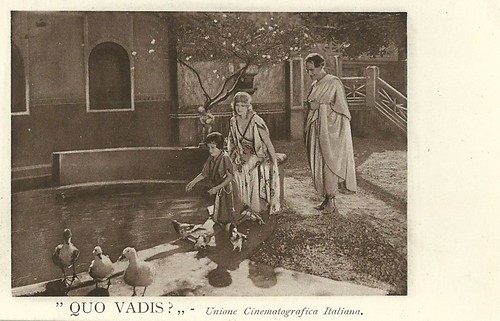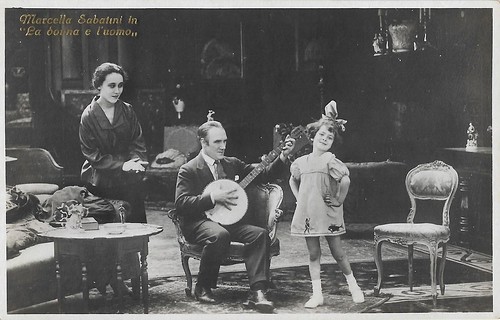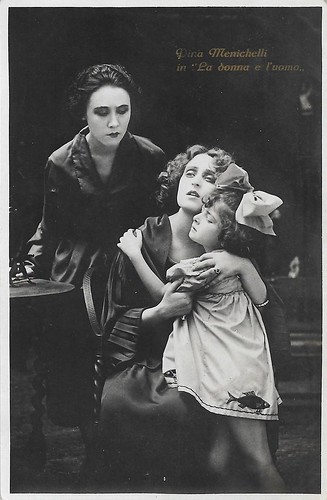
Italian postcard by Vettori, Bologna, no. 1026. "La più piccola Attrice Cinematografica" (The youngest film actress). Sabbatini's name is misspelled here as Sabattini.

Italian postcard by G.B. Falci, Milano. Photo: Fotominio. Pina Menichelli, Milton Rosmer and Marcella Sabbatini in La donna e l'uomo/Woman and Man (Amleto Palermi, 1923).

Italian postcard by Edizione L'Argentografica, Torino, no. 3049. Lillian Hall-Davis as Lygia/Licia, Alphons Fryland as Vinicius and Marcella Sabbatini as the son of Domitilla and Plautus the Italo-German epic Quo Vadis? (Gabriellino D'Annunzio, Georg Jacoby, 1924), one of the many adaptations of the classic novel by Henryk Sienkiewicz.
A celebrated child actress in Italian silent films
Marcella Sabbatini was born in Rome in 1914 into a family of revue and operetta actors. She made her film debut in 1919, while still a child, in a film by Celio. In addition to numerous films, she was portrayed, alone and with actresses such as Pina Menichelli in a series of postcards with publicity photos.
Her career took off and between 1919 and 1926 she became a celebrated child actress in Italian silent films, with over thirty films, gaining child star status. In 1919, she made her film debut in Mario Bonnard's Germana, with Maria Caserini and Mina D'Orvella. She remained with Bonnard in several subsequent films, including Per un figlio (1920), again with Caserini and D'Orvella, followed by Papa Lebonard (1920) with Ugo Piperno in the title role.
Together with Ettore Casarotti, the duo Arnold and Patata (Aldo Mezzanotte), Franco Cappelli and Mimmo Palermi, Sabbatini was part of a new generation of Italian child actors who had established themselves in those years, before the crisis in Italian film production, with the bankruptcy of the U.C.I., interrupted their careers.
In 1921 Mario Bonnard cast her in the lead role in a re-edition of the film L'amor mio non muore, in which he had starred in 1913. The cast was composed entirely of child actors under the direction of Wladimiro Apolloni.
In addition to Bonnard, the young actress also worked several times with director Herbert Brenon at La principessa misteriosa (1920), Beatrice (1921) and Il colchico e la rosa (1921). All three films were shot in Italy and starred Marie Doro. She also acted in Jacques Creusy's Liberazione (1920), with Renée Pilar, and I dannati (1921) with Linda Pini.

Italian postcard by G. B. Falci, Milano, no. 115. Photo: Films Gallone. Soava Gallone and Marcella Sabbatini in All'ombra di un trono/L'Ombra di un tron/In the Shadow of a Throne(Carmine Gallone, 1921), based on a novel by Charles Folly, 'Fleur d'ombre'.

Italian postcard by G. B. Falci, Milano, no. 117. Photo: Films Gallone. Soava Gallone and Marcella Sabbatini in All'ombra di un trono/L'Ombra di un tron/In the Shadow of a Throne(Carmine Gallone, 1921).

Italian postcard by Vettori, Bologna, no. 2001. Marcella Sabbatini and Edy Darclea in La valse ardente/The Fiery Waltz (Torello Rolli, 1921).
The little son of Domitilla
From 1920, Marcella Sabbatini often acted as the child of the Italian divas. She was the daughter of Francesca Bertini in La ferita/The Wound (Roberto Roberti, 1920) and L'ultimo sogno/The Last Dream (Roberto Roberti 1921). Pina Menichelli was her mother in La donna e l'uomo/Woman and Man (Amleto Palermi 1923) and Soava Gallone in All'ombra di un trono/L'Ombra di un tron/In the Shadow of a Throne (Carmine Gallone, 1921), and La cavalcata ardente/The Fiery Ride (Carmine Gallone, 1925). She was the child of Maria Jacobini in La casa sotto la neve/Under the Snow (Gennaro Righelli, 1922 and La bocca chiusa/The Closed Mouth (Guglielmo Zorzi, 1925).
Marcella Sabbatini also played the child of lesser female stars such as Edy Darclea in La valse ardente/The Fiery Waltz (Torello Rolli, 1921) and Enna Saredo in La figlia della tempesta/The Daughter of the Storm (Carmine Gallone, 1921), Il dubbio/The Doubt (Edoardo Bencivenga, 1921), Le due madri/The Two Mothers (Torello Rolli, 1922) and Le vie del mare/The Ways of the Sea (Torello Rolli, 1923). In 1923 Bonnard directed her again in La maschera che ride/The Laughing Mask and Il trittico/The Triptych.
In the late silent epic Quo vadis? (Gabriellino D'Annunzio, Georg Jacoby, 1924) starring Emil Jannings as Nero. Sabbatini played the little son [!] of Domitilla (Elga Brink).
In the mid-1920s, Sabbatini played opposite Rina De Liguoro in the rural drama Maremma (Salvatore Aversano, 1924) and in the De Amicis adaptation Il focolare spento/The Unlit Hearth (Augusto Genina, 1925). However, the lead in the latter film was for rising star and Genina's then-girlfriend Carmen Boni. In 1926, Washington Borg entrusted her with the lead role in the film Mi chiamano Mimì/They call me Mimì (1929), for which she received good critical acclaim, although it was her last silent film.
Sabbatini's last film was Perché no?/The Lady Lies (1930), directed by Amleto Palermi, the first of the films made by the American company Paramount for Italian cinema. The sound film was shot in the Joinville factory in France. Having abandoned show business, Marcella retired to private life. She married Alfredo Tentoni, a musician born into a family of musicians, with whom she had two sons, Fabrizio (1938) and Piero (1942). Marcella Sabbatini died in Rome, in 2001, at 86.

Italian postcard by Ed. Vettori, Bologna, no. 2007. Francesca Bertini and Marcella Sabbatini, possibly in La ferita/The Wound (Roberto Roberti, 1920). They also played together in L'ultimo sogno/The Last Dream (Roberto Roberti, 1921).

Italian postcard by Ed. G.B. Falci, Milano. Photo: Rinascimento Film / UCI. Milton Rosmer and Marcella Sabbatini in La donna e l'uomo/Woman and Man (Amleto Palermi, 1923). The woman is unknown.

Italian postcard by G.B. Falci, Milano. Photo: Fotominio. Pina Menichelli and Marcella Sabbatini in La donna e l'uomo/Woman and Man (Amleto Palermi, 1923).
Sources: Wikipedia (Italian), and IMDb.
No comments:
Post a Comment